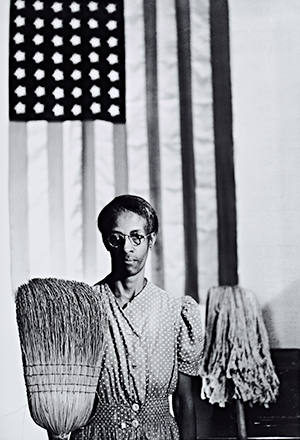The work of seven distinguished American photographers is on display at the Eric Dean Gallery in the Wabash College Fine Arts Center.
“20th Century American Photographers in the Capital Group Foundation Collection” began an eight-week run on Jan. 24, featuring the works of Ansel Adams, Edward Curtis, John Gutmann, Helen Levitt, Wright Morris, Gordon Parks, and Edward Weston. The seven photographers featured are credited with creating some of the most iconic photographic images of the last century.
“The Capital Group Foundation collaborated with members of the College’s art department to arrange this exhibition of its collection,” said Doug Calisch, Wabash College art department chair. “Featuring the work of seven distinguished American photographers whose images can be studied through a variety of lenses – cultural, historical, visual, humanitarian, and environmental – this collection underscores the mission of the gallery to promote understanding and enthusiasm for contemporary art by enriching the Wabash curriculum and challenging our ideas about the creative process.”
The exhibit highlights more than 80 quintessential images of America, from landscapes to urban scenes, and is made possible through the generous support of Wabash Trustee Kevin G. Clifford ’77, President and CEO, American Funds Distributors, Inc.
 “This work has never before been exhibited together in one place,” said Bryan Lewis, chair of the Capital Group Foundation. “Kevin encouraged us to think about showing these artists together, and this idea was the catalyst for the exhibit on display. It is because of his generosity that we are able to send these photographs to Crawfordsville.”
“This work has never before been exhibited together in one place,” said Bryan Lewis, chair of the Capital Group Foundation. “Kevin encouraged us to think about showing these artists together, and this idea was the catalyst for the exhibit on display. It is because of his generosity that we are able to send these photographs to Crawfordsville.”
Adams (1902-1984) captured the iconic landscapes of the American West with unparalleled technical genius. Drawn to the pristine beauty of Yosemite National Park after a family vacation in 1916, Adams returned every year of his life as the park became the focus of his two passions: photography and environmentalism.
Curtis (1868-1952) documented the traditions and histories of Native Americans that were rapidly disappearing by the beginning of the 20th century. He took more than 40,000 photographs of more than 80 tribes and all of Curtis’ portraits and scenes are sensitively rendered, with remarkable detail of dress and landscape.
Gutmann (1905-1998) created representations of American culture taken from the perspective of an outsider. His use of the Rolleiflex, positioned at his waist, enabled him to distort his subjects. The exotic character of this method was distinctly different from the romanticized, highly aesthetic considerations of the quintessentially American photographers.
Levitt (1913-2009) photographed the streets of her native New York City, particularly the poor neighborhoods of Spanish Harlem and the Lower East Side. Her frank, lively photographs capture the people of these neighborhoods going about their daily lives, forever caught in an instant, revealing the theater of everyday life with charm and humor.
Morris (1910-1998) distinguished himself as both a writer and photographer, linking both forms of expression. The primary aim of his work was not to strictly document, but to preserve a sense of history and place. His travels spurred Morris to create books, or “phototexts,” in which images and written words presented a composite view of his subjects.
Parks (1912-2006) is best known for his documentation of the social upheavals in America, particularly of the African-American experience during and after World War II. A self-taught photographer, Parks was the first African-American man to work on the staff of Vogue in 1944 and Life in 1948, and his documentation of the civil rights movement produced iconic images with the chaos and energy of the times.
Weston (1886-1958) began taking photographs at the age of 16 when his father gave him a simple Kodak Bulls-eye camera. To him, the camera alone had the power to capture its subject in all its beauty. In later years, Weston embarked on the monumental Project Prints series, of which the photographs on exhibition here are a part.
“The exhibition features seven significant American photographers, encompassing themes of portraiture, landscape, nature and documentary photography, and provides unprecedented access to iconic images of our cultural heritage,” said Laura Conners, director of the Eric Dean Gallery.
The exhibit is free and open to the public. The Eric Dean Gallery hours are Monday-Friday 9 a.m.-5 p.m. and Saturday 10 a.m.-2 p.m.; Hours on the final day of the exhibit – Saturday, March 22 – are 10 a.m.-5 p.m.